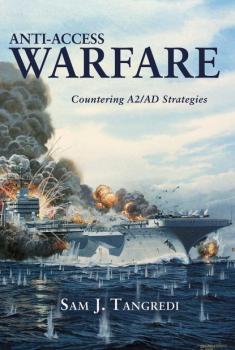Sam Tangredi
Список книг автора Sam TangrediThe U.S. Naval Institute on International Naval Cooperation
International naval cooperation encompasses the interaction of the U.S. Naval Services with the navies and militaries of treaty allies and partners nations in support of mutual defense. In addition, the term can be used to define other bilateral and multilateral defense and diplomatic activities affecting naval affairs, such as international law, rules of engagement, and arms control.Activities in support of mutual defense include bilateral and multilateral exercises, international programs such as cooperative acquisition and foreign military sales, combined training, and efforts towards increased interoperability. This volume presents an introductory discussion and selections from Naval Institute books and articles that concern these and other aspects of international naval cooperation.All naval professionals—without exception—encounter, directly participate, or play a supporting role in naval cooperation. Most apparent roles are those of foreign liaison assignments or service on alliance staffs, such as NATO staffs. But coalition operations have become the norm, and fighting alongside foreign navies is an expected aspect of current and future naval warfare.International military and naval cooperation is a specifically defined element of current U.S. national security strategy and codified in joint and Service doctrine. Obviously, an understanding of the subject is necessary in order to carry out the strategy.As part of the Naval Institute Wheel Book series, International Naval Cooperation is intended to provide a basic familiarization to all aspects of the subject and detailed understanding of relevant recent issues and development. Since there current exists no formal training on the subject for naval professionals—with the exception of certain specialized personnel—the book is designed to bridge the existing gap in knowledge. Such knowledge is as important for sea-going officers and sailors as those serving on staffs—perhaps more so, since it is at sea that cooperation brings practical results.In articles, interviews and speeches, recent Chiefs of Naval Operations have pointed to the need for high levels of pre-operational understanding and trust between allies and naval partners by using the admonition “you cannot surge trust.” Knowledge of naval cooperative programs is the first step towards being able to build such trust. And this book builds that knowledge.
Anti-Access Warfare
The book is the definitive conceptual and historical introduction to the concept of anti-access strategies. Unlike current studies, it is not simply technology focused. Nor is it primarily intended as critique of the current Air-Sea Battle concept. It combines conceptual thinking with historical examples and potential scenarios in order to identify options for future defense planning.Strategies of “anti-access,” also known as “area denial” (more recently combined into the awkward acronym “A2/AD”) are presumed to be the primary threats to the employment of U.S. military forces in overseas crises. This presumption has gradually evolved into a joint concept of “operational access.” Anti-access capabilities appear to be the current military posture of the People’s Republic of China and Islamic Republic of Iran. The study of anti-access or area denial strategies for use against American power projection capabilities has strong naval roots—which have been largely ignored by the most influential commentators. In reality, denial of access was the Soviet Navy’s operational objective during the Cold War. The first use of the actual anti-access term can be traced to a series of “anti-Navy” studies by the Office of Net Assessment designed to examine the ability of the U.S. Navy to carry out its Maritime Strategy and, later, “…From the Sea” strategic vision. Sustained long-range power projection is both a unique strength of U.S. military forces and a requirement for an activist foreign policy and forward defense. In more recent years, the logic of the anti-access approach has been identified by the Department of Defense as a threat to this U.S. capability and the joint force; countering it is one of the defense priorities identified in the President’s directions issued this past January. In addition to potential regional powers, a number of think-tanks have suggested that non-state actors, such as terrorist organizations, are developing anti-access/area denial capabilities.The book’s conclusions differ from most commentary on anti-access. Rather than a technology-driven post-Cold War phenomenon, the anti-access approach has been a routine element of grand strategy used by strategically weaker powers to confront stronger powers throughout history. But they have been largely unsuccessful when confronting a stronger maritime power. Although high technology weapons capabilities enhance the threat, they also can be used to mitigate the threat. Rather than arguing against reliance on maritime forces—presumably because they are no longer survivable—the historical analysis argues that maritime capabilities are key in “breaking the great walls.”

